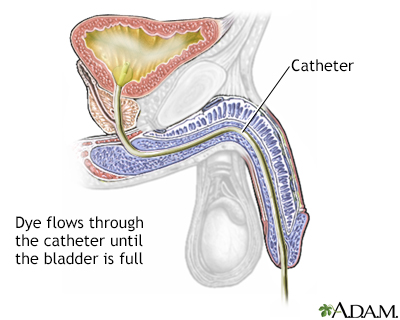Radionuclide cystogram
Nuclear bladder scan
A radionuclide cystogram is a special imaging nuclear scan test. It checks how well your bladder and urinary tract work.
Images

How the Test is Performed
The specific procedure may vary slightly depending on the reason for the test.
You will lie down on a scanner table. After cleaning the urinary opening, your health care provider will place a thin, flexible tube, called a catheter, through the urethra and into the bladder. A liquid with radioactive material flows into the bladder until the bladder is full or you say that your bladder feels full.
The scanner detects radioactivity to check your bladder and urinary tract. When the scan is to be done, depends on the suspected problem. You may be asked to urinate into a urinal, bedpan, or towels while being scanned.
To test for incomplete bladder emptying, images may be taken with the bladder full. Then you will be allowed to get up and urinate into the toilet and return to the scanner. Images are taken immediately after emptying the bladder.
How to Prepare for the Test
There is no special preparation needed. You will need to sign a consent form. You will be asked to wear a hospital gown. Remove jewelry and metal objects before the scan.
How the Test will Feel
You may feel some discomfort when the catheter is inserted. It may feel difficult or embarrassing to urinate while being observed. You cannot feel the radioisotope or the scanning.
After the scan, you may feel slight discomfort for 1 or 2 days when you urinate. The urine may be slightly pink. Contact your provider if you have ongoing discomfort, a fever, or bright red urine.
Why the Test is Performed
This test is done to see how your bladder empties and fills. It can be used to check for urine reflux or a blockage in urine flow. It is most often done to evaluate people with urinary tract infections, particularly children.
Normal Results
A normal value is no reflux or other abnormal urine flow, and no obstruction to the flow of urine. The bladder empties completely.
What Abnormal Results Mean
Abnormal results may be due to:
- Abnormal bladder response to pressure. This could be due to a nerve problem or other disorder.
- Back flow of urine from the bladder into the ureters (vesicoureteric reflux)
- Blockage of the urethra (urethral obstruction). This is most commonly due to an enlarged prostate gland.
Risks
Risks are the same as for x-rays (radiation) and catheterization of the bladder.
There is a small amount of radiation exposure with any nuclear scan (it comes from the radioisotope, not the scanner). The exposure is less than with standard x-rays. The radiation is very mild. Nearly all the radiation is gone from your body in a short time. However, any radiation exposure is discouraged for women who are or might be pregnant.
Risks for catheterization include urinary tract infection and (rarely) damage to the urethra, bladder, or other nearby structures. There is also a risk of blood in the urine or burning sensation with urination.
Related Information
PET scanReflux nephropathy
References
Di Carlo HN, Crigger CB. Vesicoureteral reflux. In: Kliegman RM, St. Geme JW, Blum NJ, et al, eds. Nelson Textbook of Pediatrics. 22nd ed. Philadelphia, PA: Elsevier; 2025:chap 576.
Khoury AE, Wehbi E. Management strategies for vesicoureteral reflux. In: Partin AW, Domochowski RR, Kavoussi LR, Peters CA, eds. Campbell-Walsh-Wein Urology. 12th ed. Philadelphia, PA: Elsevier; 2021:chap 29.
BACK TO TOPReview Date: 1/1/2025
Reviewed By: Kelly L. Stratton, MD, FACS, Associate Professor, Department of Urology, University of Oklahoma Health Sciences Center, Oklahoma City, OK. Also reviewed by David C. Dugdale, MD, Medical Director, Brenda Conaway, Editorial Director, and the A.D.A.M. Editorial team.

Health Content Provider
06/01/2025
|
A.D.A.M., Inc. is accredited by URAC, for Health Content Provider (www.urac.org). URAC's accreditation program is an independent audit to verify that A.D.A.M. follows rigorous standards of quality and accountability. A.D.A.M. is among the first to achieve this important distinction for online health information and services. Learn more about A.D.A.M.'s editorial policy, editorial process and privacy policy. A.D.A.M. is also a founding member of Hi-Ethics. This site complied with the HONcode standard for trustworthy health information from 1995 to 2022, after which HON (Health On the Net, a not-for-profit organization that promoted transparent and reliable health information online) was discontinued. |
The information provided herein should not be used during any medical emergency or for the diagnosis or treatment of any medical condition. A licensed medical professional should be consulted for diagnosis and treatment of any and all medical conditions. Links to other sites are provided for information only -- they do not constitute endorsements of those other sites. © 1997- 2025 A.D.A.M., a business unit of Ebix, Inc. Any duplication or distribution of the information contained herein is strictly prohibited.
